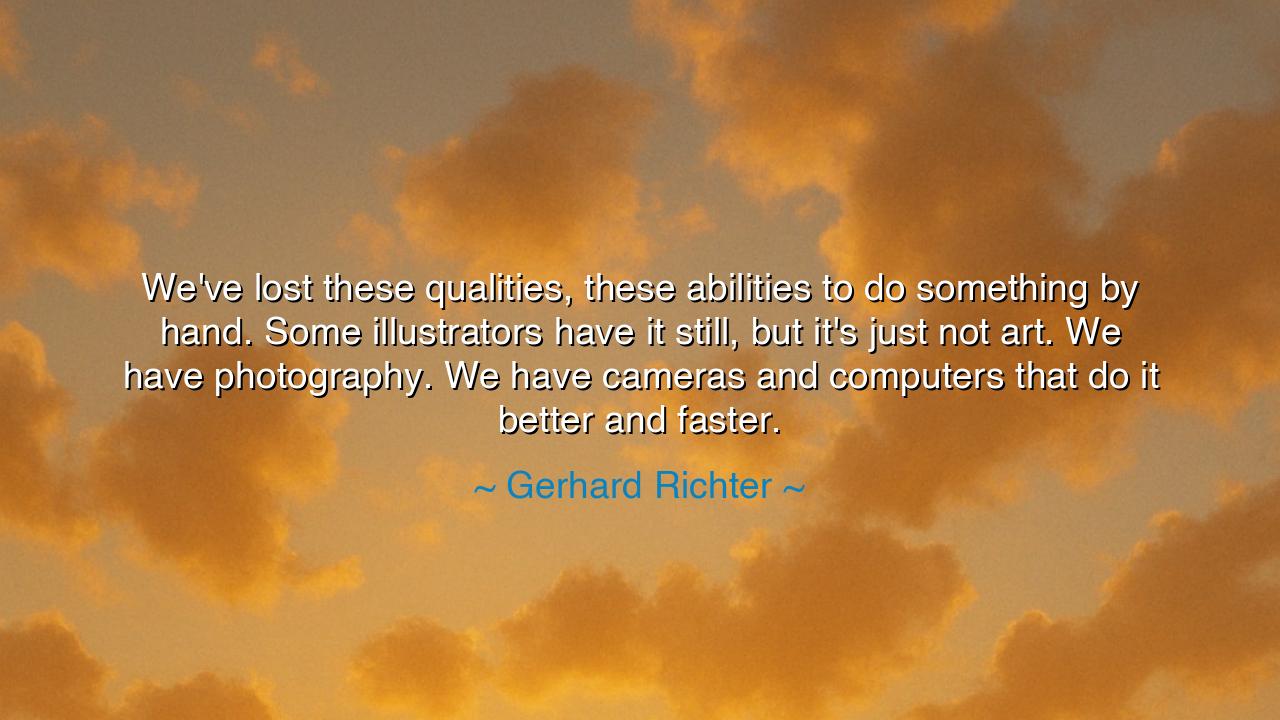
We've lost these qualities, these abilities to do something by
We've lost these qualities, these abilities to do something by hand. Some illustrators have it still, but it's just not art. We have photography. We have cameras and computers that do it better and faster.






In the twilight of the modern age, when the hand grows still and the machine hums ceaselessly, the painter Gerhard Richter spoke words heavy with sorrow and clarity: “We’ve lost these qualities, these abilities to do something by hand. Some illustrators have it still, but it’s just not art. We have photography. We have cameras and computers that do it better and faster.” His lament was not for the death of beauty, but for the vanishing touch of the human hand, that sacred bridge between soul and creation. Through his voice echoes the cry of centuries — the fear that in gaining perfection, we may lose the divine imperfection that makes us human.
In ages long past, men carved their dreams into stone with trembling fingers. The artisans of Greece, the painters of the Renaissance, the calligraphers of the East — they bled time itself into their work. Every brushstroke was a prayer, every chisel mark a dialogue between flesh and eternity. To create by hand was to wrestle with the gods, to fail and yet continue, to let sweat and flaw become the very proof of authenticity. But now, in an age of photography, cameras, and computers, the hand no longer trembles; it clicks, it taps, it commands. The old labor of the heart has been replaced by the swift precision of code and lens.
Richter himself, master of both paint and realism, walked this narrow bridge between hand and machine. He looked upon his own work and upon the works of his time, and he saw a shift not merely of method but of meaning. For when art ceases to be born from struggle — when it becomes too easy, too perfect, too fast — something of its sacred fire dims. The ancients would have said: the spirit of the craftsman withdraws when his labor no longer requires his suffering. For beauty, in its truest form, is not the absence of flaw but the presence of soul.
Consider the story of the Japanese swordsmiths of old. Each blade they forged was not only a weapon but a soul, tempered in fire and prayer. When machines arrived that could mass-produce sharper blades at a fraction of the time, the masters did not rejoice. They knew the machines could shape metal, but not meaning. The sword that cuts perfectly is not always the sword that carries honor. So too with art — the machine may imitate the hand, but it cannot inherit its spirit. The human touch, with its frailty, its hesitation, its yearning, is what breathes eternity into matter.
Richter’s lament is thus a warning wrapped in reflection: when we let the hand fall idle, the mind grows numb, and the heart forgets how to speak. We become spectators instead of creators, critics instead of dreamers. We let tools, once made to serve us, become our masters. In this new kingdom of efficiency, we trade depth for speed, meaning for clarity, mystery for exactness — and in doing so, we risk creating a world that is flawless, but lifeless.
Yet despair not, O listener of time. For though the machines may paint and the cameras may capture, they cannot feel. They cannot weep at the sight of light falling on a leaf, nor tremble as they carve the curve of a beloved face. Those who return to the craft of the hand — who sculpt, paint, write, or build with patience and imperfection — will keep alive a lineage that no circuit can inherit. To create by hand is to converse with the eternal, to join the chorus of ancestors who shaped the world before the dawn of electricity.
Therefore, let this teaching remain in your heart: use the tools of the age, but do not surrender your hands to them. Let the machine assist, but not replace; let the camera record, but not define; let the computer enhance, but never command the soul. Take time to draw, to shape, to make something slowly, even if poorly — for in that slowness lies remembrance, and in remembrance, the echo of your humanity.
And so, remember the words of the painter not as a dirge, but as a call to awakening. The age of machines may build wonders, but only the human hand, guided by the human heart, can give birth to art that endures beyond its time.






AAdministratorAdministrator
Welcome, honored guests. Please leave a comment, we will respond soon